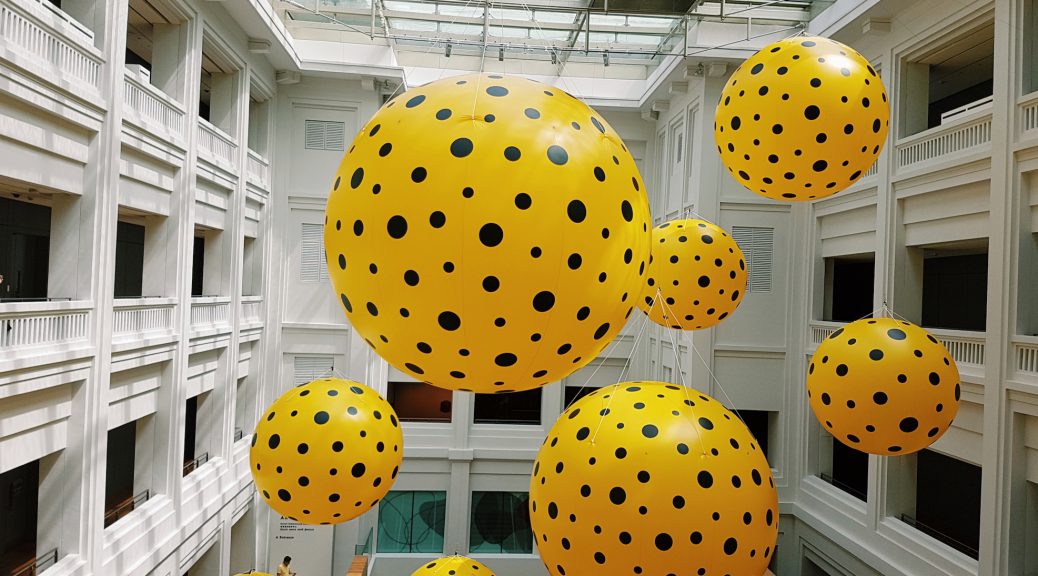1st Room: Love Forever Gallery
-
What technique is Kusama using to unify her canvases?
Kusama uses a grid format to display these various canvases, creating a composite image. Other unifying elements include a monochrome colour palette, use of lines, geometric and fluid shapes, and a free-flowing almost automatic style of drawing.
-
Describe her use of space
Kusama uses both positive and negative space to convey meaning and create focus in her compositions. Although the drawings are packed with multiple repetitive elements, the images do not feel clustered or suffocating. The individual canvases create a spatial dialogue with each other.
-
What emotional responses do you have when standing in front of her paintings? Can you observe anything about the relationship of the size of the paintings to your own body?
I feel that the wall of canvases is very immersive. I feel happily overwhelmed by their scale and intensity. They feel very energetic, wild and erratic.
-
What do the marks and forms in these black and white paintings remind you of?
They remind me of visions and a whirl of monochromatic symbols. The eye motif feels voyeuristic. The shapes and imagery are rather abject, yet also peaceful and meditative due to the repetition.
2nd Room: Walk into the Tulip Room
-
How does your emotional response change going from Love Forever to the Tulip Room?
Going from the largely monochromatic Love Forever gallery to the technicolour tulip installation, the visual juxtaposition was stark and heightened the effect of both rooms. In the Tulip room, I felt lighter albeit a little cloistered. The repetitive high-key polka dot pattern is pretty but rather plastic and manufactured.
-
Does the Tulip Room evoke any memories? What are the sculptural forms telling you?
The large sculptural forms make me feel miniature, like Alice in Kusama’s strange, obsessive Wonderland.
3rd Room: My Eternal Soul
-
Compare the use of colour to the black and white painting in Forever Love. How does the colour affect you differently? How do you feel?
The vibrant high-key colour scheme feels brighter and more inviting. The paintings are singing a cheery visual melody. They feel dynamic and bold.
-
What techniques does Kusama use to unite the colour canvases?
They are arranged in a grid format. They largely follow a high-key colour palette, and share common recurring motifs such as the eyes, sac-like forms and suggestions of the female genitalia.
-
Compare the right and left walls. What are the differences in the emotions evoked by these different walls?
The shapes in these paintings are rather similar, however the left wall feels more rigid and grounded due to the use of black to delineate the shapes. The colour palette is also darker and cooler. It feels more defined compared to the right wall which employs a complementary colour scheme in each painting (e.g. orange and blue). This right wall feels more subtle and understated.
4th Room: Narcissus Garden
-
What differences do you see between experiencing the Narcissus Garden on its own and knowing/imagining Kusama’s actions during the Venice Biennale where she wore the kimono and sold the balls?
The knowledge that they were once used to make a statement about the art market and its commodification enrich the content of the installation. Without knowing this, it feels simply like a pretty visual spectacle of metal balls. However, it feels kinda sad that these metal spheres are now displayed ‘out of context’ like artefacts in a museum, regardless of their initial stand.
Infinity Nets
-
What is meant by the term ‘Repetitive All-over Approach’?
Kusama takes a single element and repeats this unit to span large areas. The painting’s massive scale are highly immersive and fill our filed of vision, engulfing us in the dense pattern.
-
Compare your emotional responses of the white Infinity Net paintings to the coloured Infinity Net paintings on the oposite walls. What happens when you stare at these paintings?
I feel overwhelmed and engulfed in these Infinity Nets. My focus drifts around the web network, moving from unit to unit. The white nets feel very calming and create a fluffy tactile sensation. The coloured nets feel more intense due to the contrasting colour schemes. They give me a lot of ‘after-image’ after staring at them.
-
Describe 1 of the Infinity Net paintings
‘Infinity-Nets HSO’ (2016) is a large acrylic on canvas painting which depicts a white-cloud like mass. The painting consists of a dense repetition of a single circular nit applied through the entire canvas. This obsessive working process allowed Kusama to reintegrate herself into the world through ‘self-obliteration’. It also reflects Kusama’s highly disciplined and meditative working style.
Death of a Nerve
-
How does the title affect your understanding and response to the piece?
Despite the playful polka-dot plushy forms, the title immediately gives the work a more grim tone, hinting at themes of death and loss.
Pumpkins
-
Kusama’s pumpkins represent “comfort and security” for her. Talk about an object that would serve as a meaningful representation of a part of your past or signifies your family history. What is the object and why?
For as long as I can remember, during birthdays or Christmas my grandmother would always give me pig-related gifts. Pig coins, pig figurines, pig paperweights and even pig gag gifts. This yearly routine is both sweet and amusing. On my 10th birthday, she rightly gave me 10 miniature glass pigs. They were handmade so each piglet had a distinct look and colour. When playing with them one day, I accidentally dropped one and its curly tail broke off. At the time, I thought it was a great idea to put a band-aid on its butt, which remains till this day.
Pigs are often associated with laziness and gluttony. However, to me, pigs represent a joyful simplicity, and bring to mind my relationship with my grandma, and her quirky yearly tradition.













